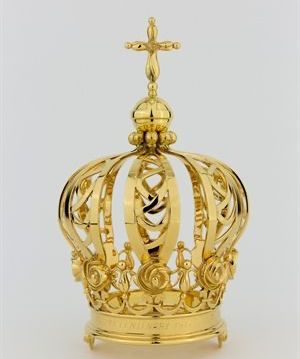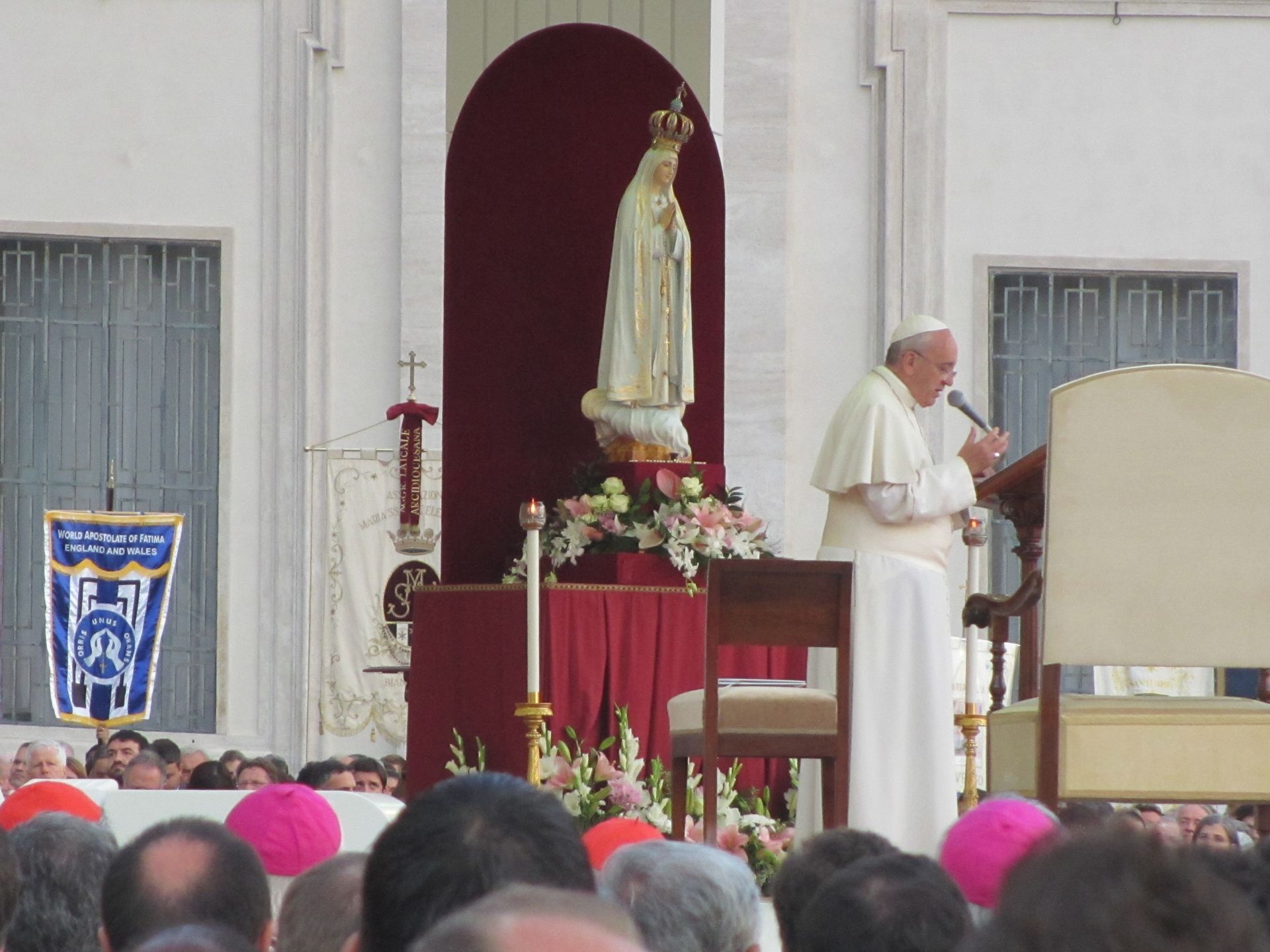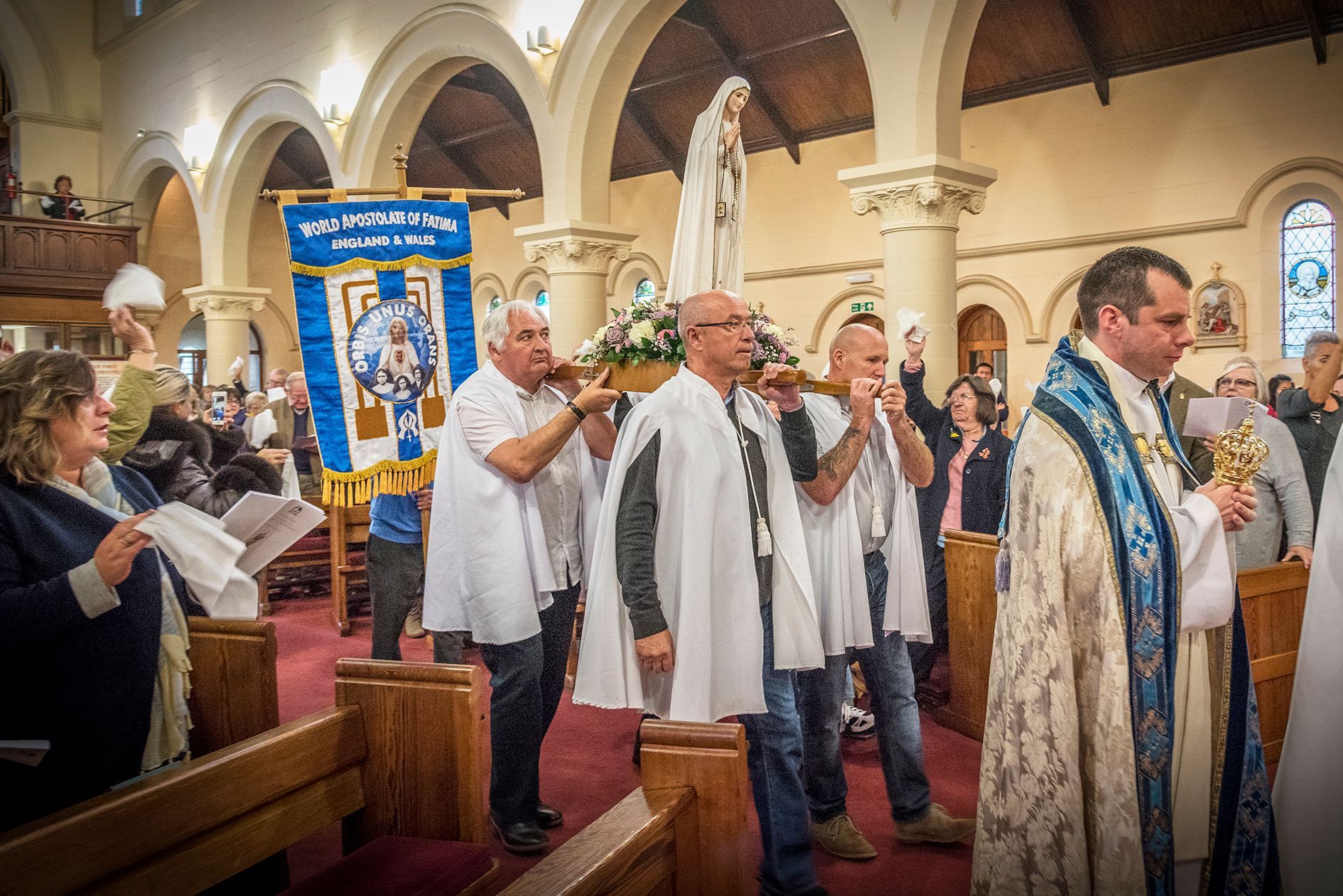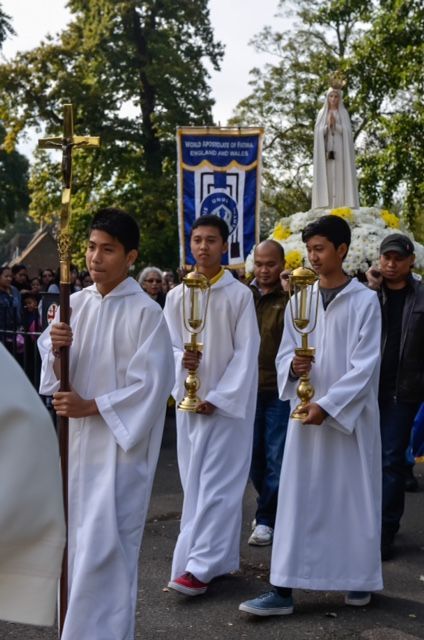The Centenary Crown
In honour of the Fatima Centenary year, the firm of Leitão & irmão in Portugal offered to Our Lady a special new silvergilt crown which they designed and created, as illustrated.
This crown is now being used for the WAF England and Wales National Pilgrim Virgin Statue, which was given to this country in 1968 by the Bishop of Fatima, and blessed by Pope Paul VI in 1967 and St John Paul II in 1982.
The richly bejewelled original crown was created in 1942. It contains the bullet that went through the body of Pope St John Paul II on 13 May 1981, and is only worn on the Statue in Fatima on the 13th of the month.
It was made by the grandfather of Mr Jorge Leitão, the managing director of his company.
To see another picture of the Crown and an explanation of its parts, please click here …
If you have any questions about the above, please contact us via this link …
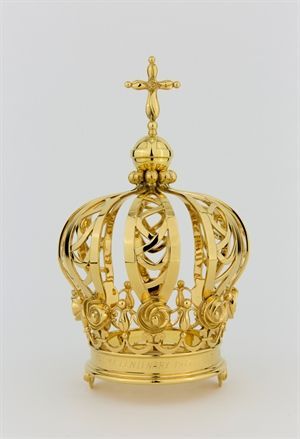
THE FATIMA CENTENNIAL CROWN
The following is the explanation for the design of the crown that was made by Mr Jorge Leitao’s family firm in Portugal, and offered by him to Our Lady in return for whatever items of gold and silver the faithful might freely wish to offer Our Lady during 2017.
This was how it was done in Portugal when in 1942 his grandfather made the very famous crown that is only worn on the 13th of the month at Fatima, in gratitude to Our Lady for preserving Portugal in peace during World War II. The precious crown is gold, which was made from the gifts of the women of Portugal, it weighs 1.2 kilos, and is decorated with 313 pearls and 2,679 precious stones.
Pope Pius XII addressed Our Lady of Fatima as Queen of Peace and of the World, when his legate, Cardinal Masella, placed this crown on the head of her statue at Fatima on 13th May 1946.
The crown of the new millennium is a reinterpretation of the crown that is present every day on the image in the Chapel of the Apparitions at Fatima.
Like the original, this work created by Leitao & Irmao was inspired by the appearance and by the message of Our Lady at Fatima in 1917.
The orb surmounted by the cross is the universal symbol in the Christian world of reigning royalty. Our Lady is Queen.
The cross is surrounded by four large rose petals symbolizing the Mother who swathes the child in her love. A rosebud blooming in the centre of the Cross evokes the life that renews itself in sacrifice.
The eight brackets that link the orb to the base of the crown are supported by eight roses in bloom with enlarged petals. The crown is closed at the top under the orb to signify its union with the base through its supporting brackets.
The band round the base is engraved with the lettering:
FATIMA CENTENARY 1917 – 2017
WORLD APOSTOLATE OF FATIMA ENGLAND & WALES
The central theme of roses evokes the title by which Our Lady proclaimed herself: I am the Lady of the Rosary.
FATIMA AFTER THE APPARITIONS
Meanwhile, work on the construction of the Capelinha, the Chapel of Apparitions, began on 28 April 1919 and was completed on 15 June; the first Mass was celebrated there on 13 October 1921. The pedestal on which the image of Our Lady stands in the Capelinha marks the exact spot where the little holm oak grew on which Our Lady appeared. In May 1922, Bishop Jose Correia da Silva of Leiria-Fatima, named a commission of enquiry to analyse the facts surrounding the Fatima phenomenon “with strictness and impartiality”.
On 10 December 1925, Sr Lucia, who had become a postulant with the Dorothean Sisters, was at their convent in Pontevedra, Spain, when she saw another apparition, this time of Mary with the Child Jesus. Mary told Lucia that she promised all the graces necessary for salvation to those who, on the first Saturday of five consecutive months, confessed, received Holy Communion, recited five decades of the rosary, and meditated on the rosary for fifteen minutes, all with the intention of making reparation to her Immaculate Heart.
Meanwhile, on 13 January 1924, Mass was celebrated for the first time inside the Capelinha, while on 26 June 1927, the bishop presided for the first time at an official event—the inauguration of the 14 kilometre Way of the Cross to the Cova da Iria, where he celebrated Mass in the presence of 400 pilgrims. Building work on he Basilica of Our Lady of the Rosary of Fatima was begun in 1928, and it was consecrated on 7 October 1953. It has 15 altars dedicated to the 15 mysteries of the Rosary. The bodies of Jacinta and Francisco were moved to their present positions, to the left and right of the main altar, in the early 1950s, and Sr Lucia’s body was interred in the Basilica in 2008 next to Jacinta’s. The mortal remains of Bishop Correia da Silva, who died in 1957, are interred in the Chancel.
Prior to this, on 13 June 1929 Sr. Lucia, while at prayer in the convent chapel at Tuy, saw a vision of the Most Holy Trinity, with Mary standing on the altar displaying her Immaculate Heart in her left hand. It was on this occasion that Mary asked the Pope, in union with all the bishops of the world, to make the [collegial] consecration of Russia to her Immaculate Heart that she had announced during the July 1917 apparition.
On 13 October 1930 the Bishop issued a pastoral letter on the apparitions, which, after recounting the events at Fatima, contained the following brief but important statement:
“In virtue of considerations made known, and others which for reasons of brevity we omit; humbly invoking the Divine Spirit and placing ourselves under the protection of the most Holy Virgin, and after hearing the opinions of our Rev. Advisors in this diocese, we hereby:
- Declare worthy of belief, the visions of the shepherd children in the Cova da Iria, parish ofFatima, in this diocese, from the 13th May to13th October, 1917.
- Permit officially the cult of Our Lady of Fatima.”
In thanksgiving for this development, six months later, on 13 May 1931, a vast pilgrimage of around 300,000 people came to Fatima to participate in a ceremony presided over by Cardinal Cerejeira, Patriarch of Lisbon, at which all the bishops of Portugal made the first consecration of their country. It was this consecration, and that of 1938, which preserved Portugal from the violent attack on the Church in the Spanish Civil War, and its renewal in 1940 saved Portugal from being dragged into the horrors of the Second World War.
Fatima developments from World War II onwards
On 31 October 1942, during World War II, Pope Pius XII, speaking in Portuguese by radio, consecrated the world to the Immaculate Heart of Mary, with a special mention of Russia, in response to the request he had received in a letter from Sr Lucia. Some months later Sr Lucia said that as a result of this act, God promised to end the war soon.
On 13 May 1946, Cardinal Masella, the Papal Legate, crowned the Statue of Our Lady of Fatima in the Capelinha as Queen of Peace. This crown was made from gold melted down from wedding rings donated by the women of Portugal, and it also contains over 4,000 precious stones, which they contributed in thanksgiving for Portugal having been spared the horrors of the Spanish Civil War and the Second World War.
On 13 October 1951, Cardinal Tedeschini, who was in Fatima for the closing of the Holy Year, revealed that in October 1950, at the time when he had promulgated the dogma of Mary’s Assumption into heaven, Pope Pius XII had witnessed a repetition of the solar miracle of 13 October 1917, while he was walking in the Vatican gardens.
Cardinal Roncalli, the Patriarch of Venice, and the future Pope John XXIII, presided at the ceremonies at Fatima on 13 May 1956, while, on 21 November 1964, Pope Paul VI, at the conclusion of the third session of the Second Vatican Council, proclaimed “the Most Blessed Mary Mother of the Church”; the Pope also considered it was “particularly opportune” to recall Pius XII’s consecration of the world to the Immaculate Heart of Mary; and bearing that consecration in mind, he announced before the 2,500 Council Fathers, that a Golden Rose was to be presented to the Sanctuary of Fatima (this act was carried out on 13 May 1965 by Cardinal Cento, the Papal Legate); and the Pope concluded his address by proclaiming, “to your Immaculate Heart, O Mary, we commend the entire human race”.
Pope Paul VI came to Fatima on 13 May 1967 to celebrate the 50th anniversary of Our Lady’s first Apparition, and to pray for world peace and Church unity. In a significant sign of papal approval for the message of Fatima, the Pope invited Sr Lucia to join him on the external altar in front of the crowds, and in his Apostolic Exhortation Signum Magnum, issued on the same day, Paul VI urged “all members of the Church to consecrate themselves once again to the Immaculate Heart of Mary and to translate this pious act into their daily lives”.
Ten years later, on 10 August 1977, the future Pope John Paul I, Cardinal Luciani, Patriarch of Venice, came on pilgrimage to Fatima.
UK HEADQUARTERS
World Apostolate of Fatima
Headquarters
International UK phone
Email:
Skype
PARISH ACTIVITIES


